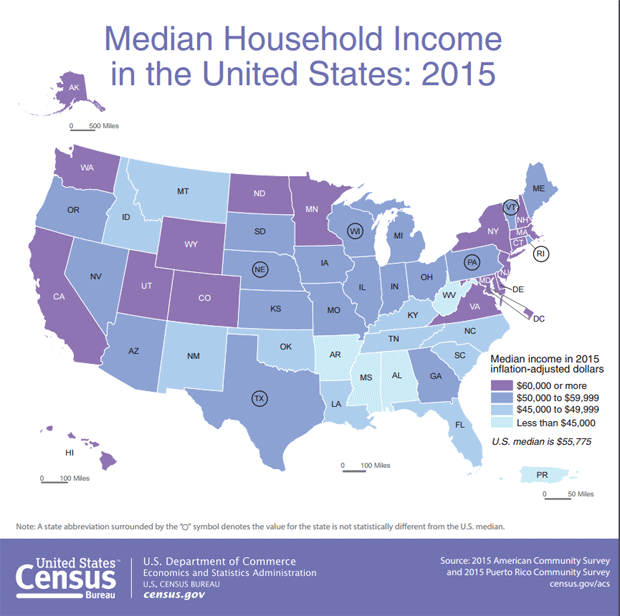Income is improving -- but not for these Americans
Americans in 2015 witnessed the best year of household income growth since the recession hit. So how come you feel poorer?
The Census Bureau’s annual report of household income was met with incredulity on some fronts, leading some Americans to ask why they hadn’t seen any of those gains in their own paychecks.
Aside from the fact that one’s personal experience isn’t going to reflect the broader trends within a country of 318 million people, the tide of economic good news is failing to lift all boats. Within the country are a number of demographic groups and regions that continue to lag.
Lots of people who were working in the 1990s can’t be blamed for feeling left behind. Households enjoyed an all-time income peak in 1999, which last year’s 5.2 percent income jump couldn’t yet top. But aside from baby boomers and Gen Xers whose income may not yet have fully rebounded, several demographic groups and regions continue to feel economic pain. They range from full-time male workers to people living in many Southern and Western states.
“Unless we make significant changes, we are increasingly going to leave some people behind,” said Tiziana Dearing, professor of social work at Boston College. “The data suggests that in general we are headed in a better direction, but when you look at states where the income is still lower and poverty is still higher, there is a Southern story here, a post-industrial story here, and that will continue to be the case.”
Take the gender pay gap, a persistent problem for women and families. Women inched closer to men last year, earning about 80 cents to every $1 their male counterparts earned, or a penny better than a year earlier. The Institute for Women’s Policy Research and other supporters of equal gender pay heralded the gain. Yet somewhat lost in the data was the fact that men are falling behind women when it comes to income gains.
Median earnings for women working full-time have increased by 7.8 percent since 2000, according to the Economic Policy Institute’s analysis of Census data. But men have seen their income shrink by 0.1 percent on the same basis.
“It’s hard to applaud a decrease in the earnings gap due to men’s earnings being more stagnant, and that’s what we see in the longer trend,” said Elise Gould, senior economist at the Economic Policy Institute, on a conference call on Tuesday.
Women without families benefited from an 8.7 percent jump in median income last year, compared with just 3.9 percent for their male counterparts. And while men still earned 40 percent more than the women without families, the gap narrowed by more than six percentage points in 2014.
Geographically, the recovery hasn’t flowed smoothly to all corners of the country. Households in the Southern states saw their median household incomes grow by only 2.9 percent last year, reaching $51,174, far below the national median income figure. By comparison, the fastest growth was enjoyed in the West, where income jumped 6.4 percent.
In 26 states, median household income was below the national figure. Many of those states are located in the South, such as Mississippi and Alabama. Only 11 states enjoyed median household incomes above their 2007 levels: Colorado, Hawaii, Iowa, Nebraska, North Dakota, Oklahoma, Pennsylvania, South Dakota, Texas, Wyoming, and Washington, EPI said.
“Despite increases in 2015, it’s worth noting that income levels in most states are still lower than they were before the Great Recession,” Janelle Jones, an EPI economic analyst, wrote in a brief.
Below are some of the lagging groups when it comes to income gains.
Men: Full-time male workers saw their earnings rise only 1.5 percent last year, far below the 2.7 percent increase for women who worked full-time. As noted above, men’s earnings on an inflation-adjusted basis are actually lower than they were in 2000. The plight of white male workers has been cited as one reason this group tends to be more supportive of Republican presidential candidate Donald Trump, who has an anti-immigration, anti-trade stance.
Southerners: With some exceptions, residents in Southern states didn’t witness the same income gains as workers in the Northeast and West. Households in the South saw income rise only 2.9 percent, compared with 6.4 percent for the West, which benefited from the highest income gains. The Northeast saw income rise 4.9 percent, while the Midwest benefited from a 5.1 percent boost. Several Southern states, including Alabama, Mississippi and Arkansas, had the lowest median household income in the U.S., according to the American Community Survey.
Rural residents: Workers who live outside the country’s metropolitan statistical areas -- an area with an urban core and high population density, such as the New York-Newark-Jersey City area -- may be the biggest losers of all. Households beyond those metropolitan areas suffered from a 2 percent income decline last year. By comparison, workers inside MSAs enjoyed a 6 percent increase in income.
